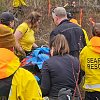"Come with an open mind, an eagerness to learn and a good work ethic.”
In March, COVID-19 sent universities around the globe scrambling to convert lessons from in-class to online. Most institutions, including Thompson Rivers University (TRU), is continuing with online courses this fall, leaving some students wondering how they can achieve their best through prolonged virtual learning.
Unlike most institutions, TRU is uniquely poised to draw from the experts within its Open Learning (OL) division, which has been delivering distance and online courses for 42 years. This summer, campus faculty have been working with OL to learn more about online teaching to help students have a great experience this September.
One of those campus faculty members, Nancy Van Wagoner, teaches geology. She said her course materials were already online, so switching to the virtual world wasn’t too difficult. Her students met via videoconferencing and worked in smaller-than-usual groups when they had labs.

She learned as she went and made adjustments that she will continue to use this fall, such as dividing her 50-minute lectures into shorter topics presented with videos (no talking heads). Virtual 3-D materials were used for labs, she had an open videoconference site where students could meet informally and she emailed her students frequently for announcements, reminders, clarifications and other details.
“We still met on a regular basis. I also held (virtual) office hours and Q and A sessions. We came together to go over the problem sets and material. I think it was fun and interesting and that we had a very positive end to the term. Actually, the truth is that I was kind of sad when the winter term was over,” she said.
Van Wagoner said some of the lessons she learned from the winter term experience include:
- Students appreciated having a schedule, short assignments and small assessments to help keep them on track.
- Students wanted to engage with each other, both formally for labs and also informally.
- The conditions for students studying from home are variable and so it is important to be sensitive, empathetic and flexible, and offer appropriate support.
She also learned teaching online has many positive sides to it.
 “There is a lot to like about making the best use of information and communication technology in teaching and learning. I enjoy the creative aspect of new course design and developing the learning materials, exercises and virtual field trips,” she said.
“There is a lot to like about making the best use of information and communication technology in teaching and learning. I enjoy the creative aspect of new course design and developing the learning materials, exercises and virtual field trips,” she said.
“Here is another great thing—every student has a front-row seat. I encourage my students to turn on their video cameras, but I can see their names even if they chose not to show their faces. I find students are much more willing to interact and ask questions using the chat function (of the virtual class program) than they are to ask questions in class.”
 Tony Bell, who has years of experience teaching online through TRU Open Learning, said one of the advantages of face-to-face classes is that they follow a routine, which is why he suggests students make a schedule and stick to it, even if it doesn’t seem as if there’s much to be done.
Tony Bell, who has years of experience teaching online through TRU Open Learning, said one of the advantages of face-to-face classes is that they follow a routine, which is why he suggests students make a schedule and stick to it, even if it doesn’t seem as if there’s much to be done.
“Give time to each class each week. Never skip a class for an entire week. Reach out to profs if you feel you are falling behind or missing something – many of your profs are new to this too, so they’ll want the feedback,” he advised.
Students learning online should understand they are working more independently than they would if they were in a classroom. And they must be aware that, just like in the classroom, they can expect different ways of teaching from different faculty members.
“If they take several courses, they should expect to see many different styles from their professors. Some professors will have lots of ‘live’ classes where students are expected to attend, while others will not. This is appropriate, depending on the content of the class, but it may surprise students to have online classes delivered in a very different way,” he said.
 The biggest challenge for many students studying online is staying engaged and motivated. It’s very easy to push work aside or get distracted, which is why Bell recommends a Chrome extension like StayFocusd that allows students to block sites they know will pull their attention, like Facebook and YouTube.
The biggest challenge for many students studying online is staying engaged and motivated. It’s very easy to push work aside or get distracted, which is why Bell recommends a Chrome extension like StayFocusd that allows students to block sites they know will pull their attention, like Facebook and YouTube.
“Also, if you are on a laptop and are trying to study for an hour or two, switch the phone off. It’s so easy to get distracted when our learning device, entertainment device and social device are all the same device. As much as possible, try to block those sites and apps that would distract you,” Bell said.
Students have lots of resources available to support them, from faculty members themselves to the learning technology team to academic supports and health and wellness, said Open Learning’s Learning Technology and Innovation Director Brian Lamb.
“I also urge students to contact reference librarians when they have significant projects, they are amazingly helpful,” he said.

“I encourage students to check out the TRU website so they are aware of the supports and programs that are available. In terms of technology, I encourage them to contact [email protected]. We will also be launching on Moodle and elsewhere to walk through some of the common things they may be expected to do.”
While it’s ideal that students have a quiet dedicated study space where they have no interruptions and technology that works smoothly, Lamb recognized that’s almost impossible to achieve.
“Many of us are in not-perfect spaces or have significant caregiving responsibilities. We have been asking our instructors to keep in mind what challenges people are up against and to plan accordingly,” he said.
“If I can share one thing that I do more of while working remotely, it is more of a commitment to keeping a careful work calendar of appointments and deadlines. I am also making an effort to maintain a lot of to-do lists. It isn’t perfect, or easy, but I would encourage students to take a bit more time than they would before on having a system for tracking and scheduling their work than they would in ‘normal’ times.”
 If there’s one point of emphasis, it’s communicating with the instructor. Van Wagoner said before COVID-19 hit, she held regular office hours but students rarely used them.
If there’s one point of emphasis, it’s communicating with the instructor. Van Wagoner said before COVID-19 hit, she held regular office hours but students rarely used them.
“Instead, they usually email me and we set up a mutually convenient meeting time, or they might send me a question in an email and I answer by email,” she said.
And so she expects to continue ‘meeting’ students via email, but she also has a chat box where students can ask questions.
“What I tell my students is, if you are having difficulties, please get in touch with me. This is particularly important in a remote teaching and learning environment,” Van Wagoner said.
“I will also reach out to my students individually. If I notice a student is absent quite a bit, doing poorly, missing assignments, I try to reach out and see how I can help, or direct them to appropriate support services.”

In her own (now) online ‘classroom,’ Van Wagoner said she will be sticking to a schedule, with set times for labs that use some hands-on, some online simulations, 3-D models and virtual field trips. There will be assignments and materials will be on Moodle. Tests will be short and cumulative so there won’t be a final exam.
“I do this because studies have shown that this approach enhances learning, helps students keep up with the material and is a bit of a buffer against procrastination. It is certainly less stressful and none of us need more stress in our lives these days,” she said.
Her advice to her students, which really applies to all attending university this fall: “Come with an open mind, an eagerness to learn and a good work ethic.”
To learn more about studying at Thompson Rivers University this fall, click here.

At Thompson Rivers University, student success is our priority. We empower our students to reach their goals with on-campus and online learning options, individualized student services, hands-on learning opportunities and a diverse, inclusive environment.
NowMedia sponsored content is written and posted in partnership with participating businesses. While NowMedia retains editorial control of sponsored content, the content is created in collaboration with the sponsor.
















